Over the last five years at usabikers.net, we’ve had the incredible opportunity to put some of the Best Xc Mountain Bikes through their paces. From the innovative Trek Supercaliber to the budget-friendly Canyon Lux World Cup, and the subtly sophisticated Cervelo ZFS-5, we’ve rigorously tested a range of outstanding full suspension race machines.
These bikes, while each unique in their design and performance, collectively showcase the significant advancements in cross-country (XC) mountain biking. As racecourses become more technically challenging, we’ve observed a widespread integration of features like dropper posts, wider handlebars, and more powerful brakes. These enhancements significantly boost rider confidence and control. Frame designs now accommodate wider chainlines for larger tires, and slacker head angles are becoming standard to improve stability at high speeds. Furthermore, models like the Orbea Oiz, Scott Spark, and Specialized Epic 8 are demonstrating a trend towards increased suspension travel, providing enhanced traction and comfort on rougher trails.
The evolution of modern XC bikes means they are universally excellent. But the crucial question remains: which one stands out as the best XC mountain bike among them?
These advancements have not only enabled elite athletes to push their limits further but have also broadened the appeal of shorter travel bikes to everyday riders. The best XC mountain bikes of today are far removed from the overly sensitive and unstable bikes of the past. In fact, many are genuinely enjoyable to ride and surprisingly versatile. Many models can even be adapted into lightweight trail bikes by accommodating longer stroke shocks and forks.
With so many impressive new models emerging, we delve into the crucial question: Which is truly the best XC mountain bike? Here, we present our in-depth review of the top 14 full suspension XC bikes we’ve tested. We’ll highlight what impressed us, areas for improvement, and ultimately, our top pick from this elite group.
 Advertisement banner for ad blocker
Advertisement banner for ad blocker
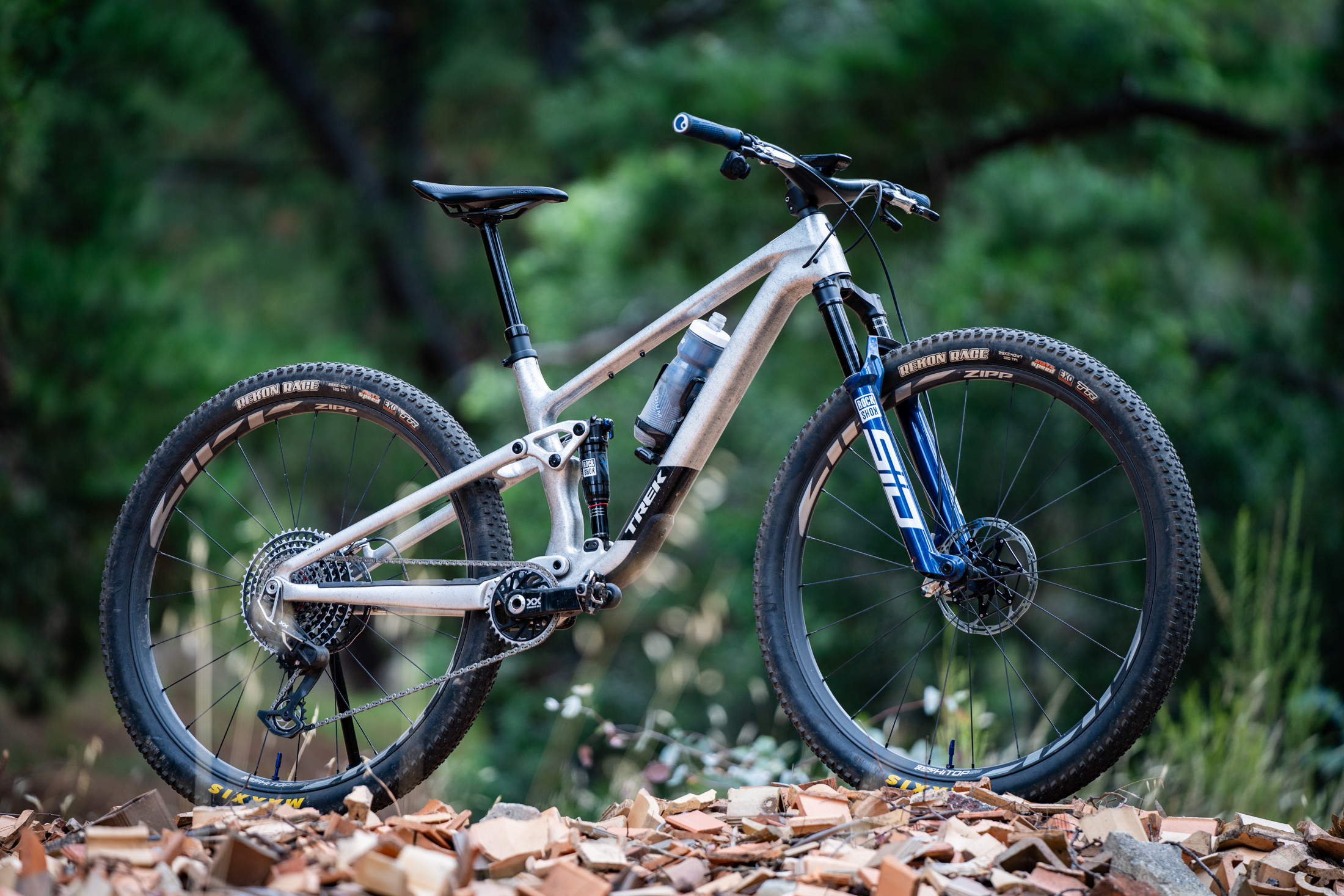 Side view of the 2025 Trek Top Fuel 120mm XC bike showcasing its frame designThe 2025 Trek Top Fuel’s adaptable design makes it an outstanding 120mm travel XC bike.
Side view of the 2025 Trek Top Fuel 120mm XC bike showcasing its frame designThe 2025 Trek Top Fuel’s adaptable design makes it an outstanding 120mm travel XC bike.
Trek Top Fuel
- Pros: Exceptional traction with ABP suspension, superior fit and handling, versatile travel and setup options, well-considered components.
- Cons: Frame not the lightest in class, no remote lockout routing, single bottle cage, stiff Bontrager RSL cockpit.
The Trek Top Fuel underwent a significant revamp for 2025, though the visual changes are subtle. While maintaining a similar silhouette to its predecessor, the 4th generation Top Fuel features a redesigned frame with slimmer tubing, resulting in reduced weight and enhanced compliance and tracking on rough terrain.
A notable addition is the unique 4-position Mino Link at the lower shock mount. This feature allows riders to fine-tune both geometry and rear suspension leverage rate. Furthermore, the rear travel can be adjusted to 120mm or 130mm simply by altering the shock stroke. Compatible with 120-140mm travel forks, the latest Top Fuel is undeniably the most adaptable iteration yet.
 Advertisement banner for ad blocker
Advertisement banner for ad blocker
Our initial test of the Top Fuel 9.8 GX AXS in its stock configuration revealed its excellent all-around capabilities. Subsequently, by extending both the fork and shock, upgrading to more aggressive tires, and modifying a few components, we transformed it into a high-performance 140/130mm travel trail bike.
More recently, we explored the opposite end of the spectrum, configuring the Top Fuel as a 120/120mm travel XC bike. It performed admirably in this setup, particularly with the RockShox SID fork and adjustments to the rear shock. While serious racers might find the 2.6kg frame weight and lack of remote lockout routing less appealing, and the single bottle cage limiting, the Top Fuel delivers exceptional handling and technical capability for a 120mm travel bike. It’s a strong contender for the best XC mountain bike if these factors are not primary concerns.
The 2024 Specialized Epic 8, a top-tier XC bike, is also the most expensive model we’ve tested.
Specialized Epic 8
- Pros: Active suspension, custom-tuned fork & shock, modern geometry, SWAT storage, lightweight and practical frame.
- Cons: Premium pricing across the range, especially the S-Works model.
The Specialized Epic has been a prominent name in XC biking since its debut in 2002. Initially recognized for its Brain shock system, the Epic was known for its efficient, hardtail-like pedaling. However, the Brain system added weight and complexity, and resulted in a less forgiving ride on rough terrain.
The 2024 Epic marks the most significant evolution in its history. Specialized has completely eliminated the Brain system and increased suspension travel to 120mm both front and rear. Combined with progressive XC geometry and an adjustable Hi/Lo flip chip, the Epic 8 offers a significantly smoother and more capable descending experience compared to previous models.
 Advertisement banner for ad blocker
Advertisement banner for ad blocker
Despite the increased travel, it remains a fast climber, thanks to its lightweight frame and intelligent 3-position suspension. Featuring custom RockShox internals, the SID fork and SIDLuxe shock offer Open, Lock, and a Magic Middle setting for a responsive pedaling platform.
Most Epic models include a TwistLoc remote for suspension mode switching. The flagship S-Works model features the advanced RockShox Flight Attendant system for automatic mode adjustment. While exceptionally priced, the S-Works Epic 8 sets a new performance standard for XC suspension and is arguably a top contender for the best XC mountain bike.
The Epic 8 also boasts features like SWAT downtube storage, a hidden steering limiter, and guided internal cable routing. For a comprehensive overview, see our detailed Specialized Epic 8 review.
The Specialized Epic EVO utilizes the same frame as the race version but increases fork travel to 130mm.
Specialized Epic EVO
- Pros: Exceptional handling, smooth and capable suspension, trail-ready build kit, SWAT storage, user-friendly frame design.
- Cons: Fox shock and dropper post issues, high entry price, no alloy models available.
The Specialized Epic EVO is a new XC bike for 2024, positioned alongside the Epic 8 race bike. It shares the same full carbon frame, including SWAT storage, Hi/Lo geometry flip chip, threaded BB, and guided internal cable routing. While maintaining 120mm of rear travel, the Epic EVO features a longer 130mm Fox 34 fork.
To enhance its trail capabilities, Specialized equipped the Epic EVO with more powerful brakes, grippier tires, and a longer stroke dropper post. The riding position is also more relaxed due to a shorter stem and wider handlebar.
 Advertisement banner for ad blocker
Advertisement banner for ad blocker
These modifications result in a noticeably different ride feel. The Epic EVO delivers a plusher ride and increased confidence on challenging descents. Its capability is remarkable for a 130/120mm travel bike, making it a strong contender for the best XC mountain bike for riders who prioritize trail performance.
The robust component package does add weight, and the chunkier tires slightly reduce climbing efficiency compared to the Epic 8. The absence of a remote lockout might deter serious racers.
However, for riders less focused on racing, the Epic EVO is an exceptionally fun and capable XC bike. For further details, check out our Specialized Epic EVO review.
The Canyon Lux Trail offers increased travel, slacker geometry, and in-frame storage compared to the Lux World Cup.
Canyon Lux Trail
- Pros: Excellent suspension, naturally efficient, responsive handling, smart storage solutions, outstanding value across the range.
- Cons: Ride not the most forgiving, cockpit ergonomics could improve, cluttered cable routing.
The Canyon Lux Trail, introduced in 2021, is a longer travel variant of the Lux race bike. To manage costs, it initially shared a rear end with the Lux, but featured a unique, slacker, and longer front triangle. Combined with a 120mm fork and practical components, it offered a cost-effective addition to Canyon’s lineup. However, it wasn’t without its drawbacks.
For 2024, Canyon significantly redesigned the Lux Trail. The new carbon frame features a 120mm fork and 115mm of rear travel and marks Canyon’s first mountain bike with internal storage. The storage hatch is well-designed, and the optional top tube mounted multi-tool is a thoughtful addition.
Practical features include a threaded BB and tool-free thru-axles, though the cable routing is less refined. The control lines routed through the headset create a busy cockpit area. Given the Lux Trail’s efficiency, eliminating the remote lockout could have resulted in cleaner aesthetics and improved dropper post lever ergonomics.
Despite these minor issues, the Lux Trail excels on the trail. While heavier than the Lux World Cup, it remains agile in tight singletrack. The smoother suspension and long-stroke dropper post enhance descending capabilities, making it enjoyable on technical terrain and a strong contender for the best XC mountain bike in its category. Read our full Canyon Lux Trail review for more details.
The Cervelo ZFS-5 is Cervelo’s debut full suspension mountain bike, leveraging expertise from Santa Cruz.
Cervelo ZFS-5
- Pros: Exceptionally smooth ride quality, plush and responsive suspension, lightweight yet practical frame, excellent component package.
- Cons: 100mm XC builds lack a dropper post, headset cable routing may be undesirable for some.
The ZFS-5, Cervelo’s first full suspension mountain bike, benefits from the expertise of its sister brand, Santa Cruz.
While sharing DNA with the Blur, the ZFS-5 is a distinct model with its own carbon frame, claimed to be among the lightest at 1,718g. It features unique geometry, including a slack 66.6° head angle on our test bike.
The ZFS-5 is offered in two configurations: a 100/100mm travel XC race bike and a more versatile 120/115mm travel trail bike. The frame is consistent across both, with shock and fork stroke variations defining the ride characteristics.
Even in its longer travel configuration, the ZFS-5 offers neutral pedaling and responds well to rider input. The lightweight chassis enhances climbing performance, and the modern geometry provides balanced handling across diverse trails. Combined with a superb build and plush suspension, the ZFS-5 is a fantastic and fun XC bike, and a strong contender for the best XC mountain bike from a new player in the segment. See our comprehensive Cervelo ZFS-5 review for further information.
The Trek Supercaliber is a standout XC race bike at the elite levels of competition.
Trek Supercaliber
- Pros: Striking frame design, powerful pedaling efficiency, responsive handling, modern component kit.
- Cons: Limited travel less forgiving on very rough trails, complex shock servicing and tuning, expensive.
The visually striking Trek Supercaliber has been completely redesigned for 2023. Trek introduced two new frames with updated geometry, increased travel, and a new RockShox-manufactured IsoStrut shock, replacing the previous Fox version.
The distinctive IsoStrut suspension remains, now with 80mm of rear travel for improved grip and comfort. Despite the increased travel, the Supercaliber maintains exceptional pedaling efficiency due to a higher main pivot that enhances anti-squat. A dual remote lockout is included, though the rear suspension’s responsiveness makes it largely unnecessary during power transfer.
Descending performance is enhanced by a slacker 67.5° head angle, a longer wheelbase, and a 110mm travel fork. Most Supercaliber models come standard with 2.4in tires and a dropper post, valuable additions for a modern XC bike.
However, it’s not the most forgiving bike on very rough terrain, especially compared to 120mm travel models like the Spark and Oiz. The cockpit ergonomics on our SLR 9.8 GX AXS test bike were also not ideal, and the cable clutter is less refined than the Epic World Cup.
Despite these minor drawbacks, the Supercaliber delivers razor-sharp handling and explosive pedaling performance, effectively bridging the gap between a hardtail and a traditional full suspension bike, and making it a top contender for the best XC mountain bike for racers. Our detailed Trek Supercaliber review provides a comprehensive analysis.
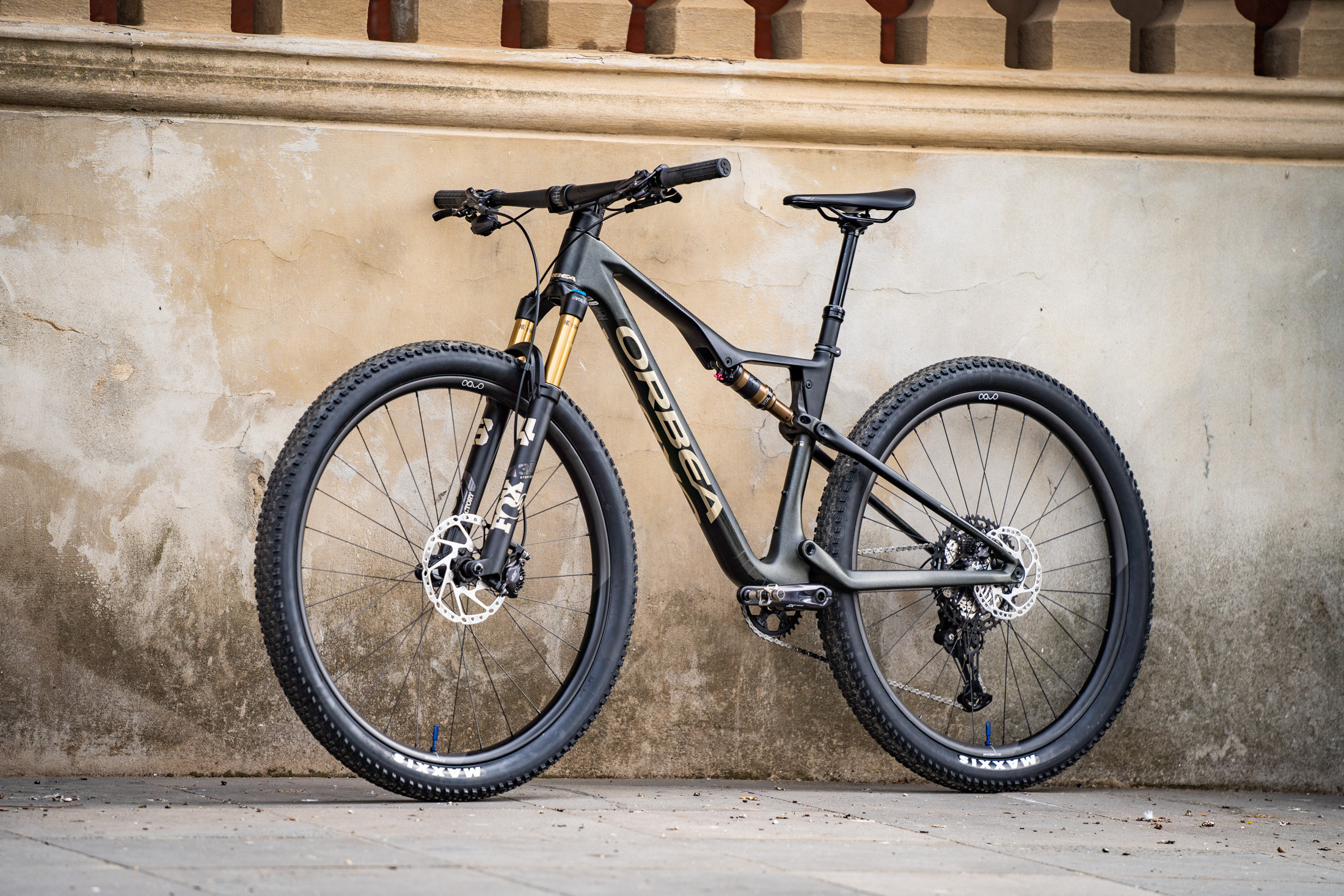 Side view of the 2023 Orbea Oiz M10 showcasing its lightweight frame and componentsThe Orbea Oiz, with its 120mm travel and excellent geometry, is a highly appealing XC bike for 2023.
Side view of the 2023 Orbea Oiz M10 showcasing its lightweight frame and componentsThe Orbea Oiz, with its 120mm travel and excellent geometry, is a highly appealing XC bike for 2023.
Orbea Oiz
- Pros: Lightweight and elegant frame, superb geometry, plush and adaptable suspension, wide range of spec options including alloy models.
- Cons: Headset cable routing, not the quietest bike, limited clearance for a second bottle.
While previous Orbea Oiz models offered 100mm and 120mm travel options on the same chassis, the latest Oiz is specifically designed around 120mm of travel, front and rear. This focused approach allowed Orbea to optimize the geometry for modern XC riding. Combined with increased travel, standard 2.4in tires, and a dropper post, the Oiz is both fun and capable, and a strong contender for the best XC mountain bike for versatile riders.
It remains incredibly light, with the top-end OMX carbon frame claimed to weigh just 1,750g including the shock. It’s also remarkably quick uphill, thanks to efficient pedaling and remote-activated suspension.
The Squidlock remote, while functional, offers a Medium suspension mode that firms up the rear shock while leaving the fork open. This enhances technical climbing and steering precision on flowy singletrack by steepening angles and raising the BB, while maintaining front-end compliance. For a detailed ride experience, see our full Orbea Oiz review.
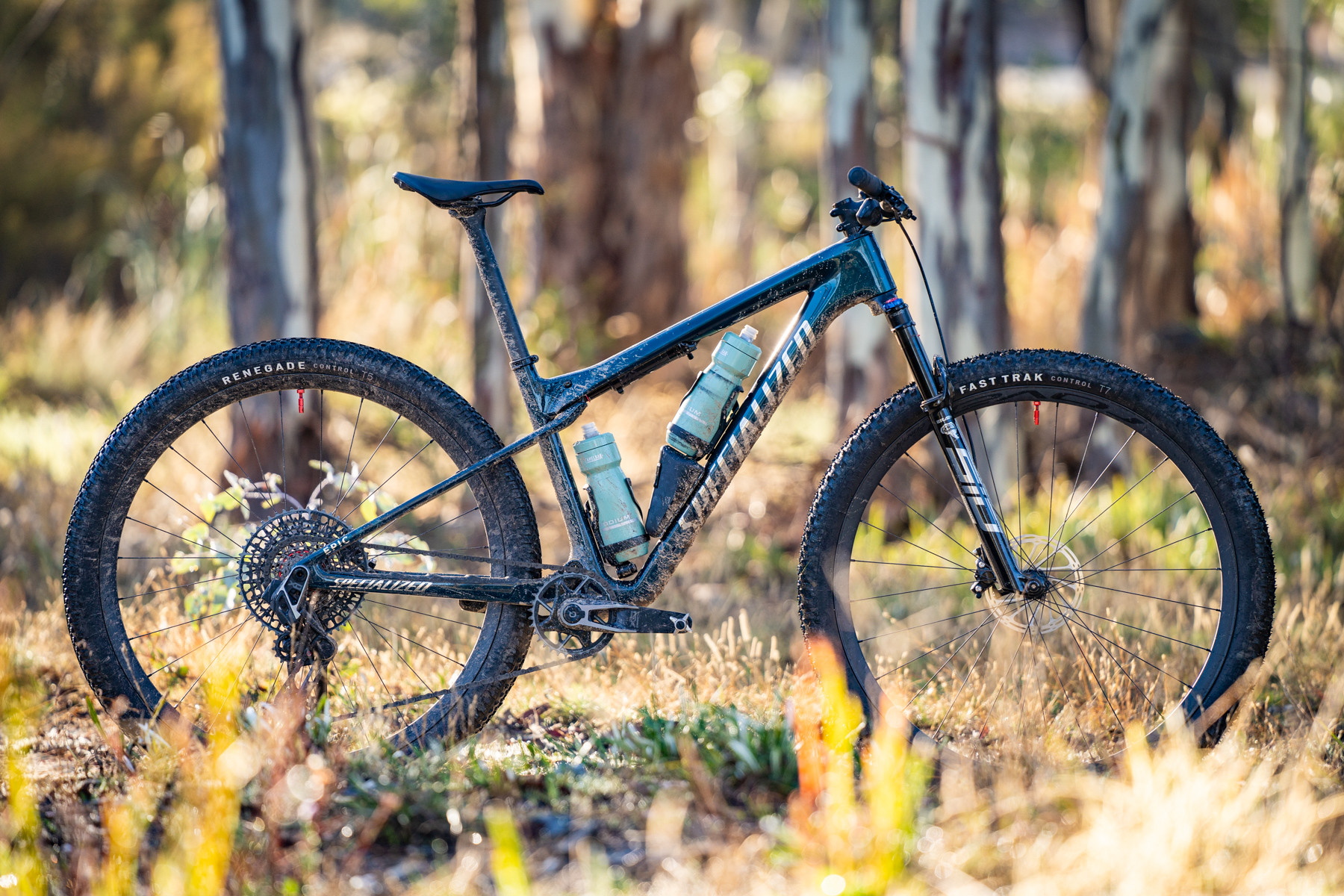 Close up of the 2023 Specialized Epic World Cup Pro highlighting its unique shock designThe Specialized Epic World Cup is similar to the Trek Supercaliber in short travel design but with notable performance differences.
Close up of the 2023 Specialized Epic World Cup Pro highlighting its unique shock designThe Specialized Epic World Cup is similar to the Trek Supercaliber in short travel design but with notable performance differences.
Specialized Epic World Cup
- Pros: Exceptional automated efficiency, superb geometry, tunable shock, clean cockpit, very lightweight, dual bottle capability.
- Cons: Ride can be harsh outside race pace, Brain fork jarring on rocky terrain, proprietary shock untested long-term, expensive.
The Specialized Epic World Cup, a new model for 2023, is the culmination of a 4-year project aimed at creating the ultimate XC race bike. It blends the responsiveness of a hardtail with the control of a full suspension bike, aiming for the best XC mountain bike for competitive racers.
Specialized abandoned the Brain damper and partnered with RockShox to develop the SIDLuxe WCID shock. Instead of an inertia valve, this shock uses an air spring design that allows independent tuning of the negative and positive chambers. This results in a tunable system that offers hardtail-like acceleration in its firmest setting.
The proprietary shock provides 75mm of rear travel, paired with a custom RockShox SID SL fork with 110mm of travel and an updated Brain damper. All components are built around a new, exceptionally lightweight carbon fiber chassis.
While rear travel is limited, the geometry is progressive, featuring a 66.5° head angle and a significant 58mm BB drop. This combination creates a highly responsive and engaging ride, best suited for aggressive, fast riding. Riders seeking a plusher, more versatile XC bike may prefer the longer travel Epic EVO.
However, for pure efficiency, the Epic World Cup is unmatched, offering a remarkably clean cockpit without lockout controls. Our Specialized Epic World Cup review provides a complete overview.
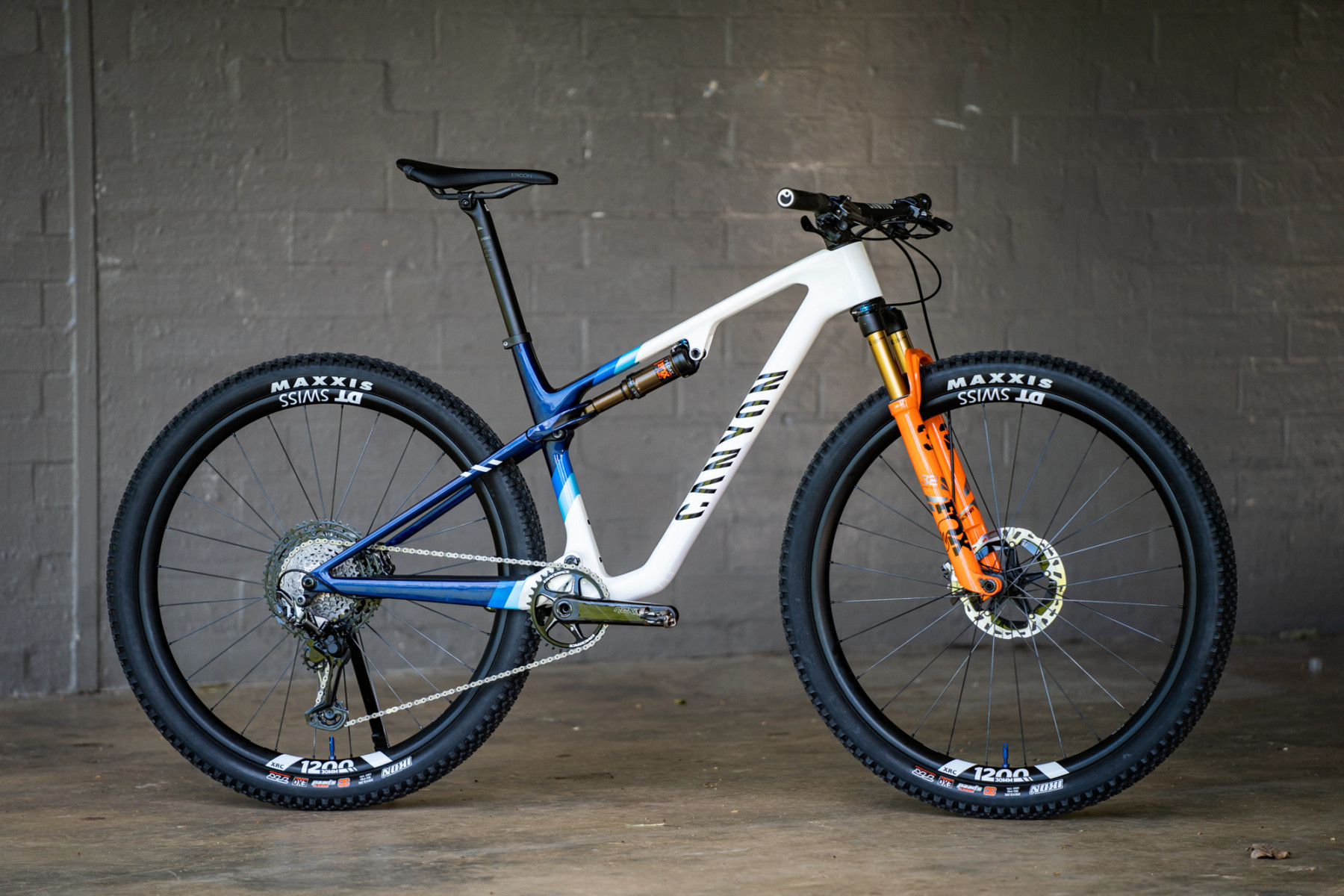 Action shot of the 2023 Canyon Lux World Cup CFR Team in a race settingThe 2023 Canyon Lux World Cup is Canyon’s lightest full suspension bike to date.
Action shot of the 2023 Canyon Lux World Cup CFR Team in a race settingThe 2023 Canyon Lux World Cup is Canyon’s lightest full suspension bike to date.
Canyon Lux World Cup
- Pros: Organic pedaling efficiency, precise handling, high-tech bearings, dual bottle capability, exceptional value for money.
- Cons: Racy suspension feel not for everyone, headset cable routing, fork feels under-gunned, no dropper post included.
Positioned alongside the longer travel Lux Trail, the Canyon Lux World Cup is the dedicated race machine in the Lux lineup. It features 100mm of travel and a new carbon frame that Canyon claims is among the lightest available, aiming for the title of best XC mountain bike for competitive cyclists.
The updated geometry enhances balance and high-speed stability compared to its predecessor. This, combined with its race-tuned chassis and suspension, results in outstanding pedaling efficiency and responsive handling in tight singletrack.
While the frame is robust and encourages aggressive riding, the Fox 32 SC fork can feel somewhat under-gunned. The absence of a dropper post on any Lux World Cup model is also surprising. Combined with the firm suspension, the Lux World Cup is less plush and confidence-inspiring on rough terrain compared to modern bikes like the Scott Spark or Merida Ninety-Six.
For a more versatile XC experience, the Lux Trail is recommended. However, for a lightweight, agile, and highly efficient race bike, the Lux World Cup offers exceptional features and components for its price point. Our Canyon Lux World Cup review details the stock bike, and our long-term review explores its full potential with component upgrades, suggesting it could be further optimized to be the best XC mountain bike for specific riders.
The Scott Spark RC’s 120mm travel at both ends provides impressive control and comfort on challenging trails.
Scott Spark RC
- Pros: Progressive geometry, plush and traction-rich suspension, versatile chassis, adaptable TwinLoc system.
- Cons: Pedaling efficiency dependent on remote use, headset cable routing complicates maintenance, frame noise.
The latest Scott Spark, launched in 2021, made a significant impact. Replacing a highly successful XC bike, the 4th generation Spark impressed with its advanced carbon frame and hidden rear shock. Featuring an updated TwinLoc remote and adjustable headset cups, the Spark also pushed geometry boundaries. Its suspension travel was extended to 120mm at both ends, setting a new standard for World Cup XC race bikes and positioning itself as a potential best XC mountain bike.
Despite these innovations, the Spark still relies on a handlebar remote and two cables for suspension control. The remote is essential to maximize performance, as the pedaling is intentionally soft and drivetrain-neutral in the full travel ‘Descend’ mode. Riders averse to remotes may not find the Spark appealing.
However, for those comfortable with remotes and headset cable routing, the Spark offers adaptable performance, excelling as both a technical climber and a fun descender. The plush suspension and low BB enhance cornering, providing traction and comfort in demanding situations. It is a highly capable XC race bike, and a strong contender for the best XC mountain bike overall due to its versatility. Our Scott Spark RC review provides a detailed analysis.
The Giant Anthem is considered one of the best XC race bikes due to its excellent all-around performance.
Giant Anthem
- Pros: Very lightweight frame, fantastic all-round handling, updated Live Valve excellent for XC racing, near-flawless modern component kit, clean cable routing.
- Cons: Initial test frame cracked, Live Valve adds complexity and clutter, single bottle cage only.
The Giant Anthem, a popular and long-standing XC bike, underwent a major redesign in 2022. Moving from its Maestro suspension to a simpler single pivot, the new Anthem frame significantly reduced weight, becoming one of the lightest options available and a contender for the best XC mountain bike in terms of weight.
While weight decreased, suspension travel increased by 10mm to 100mm rear travel, paired with 110mm Fox 34 SC or RockShox SID forks. Dropper posts and 2.4in Maxxis WT tires are standard across models, along with longer reach and a modern 67.5° head angle.
Most Anthems feature manual remote lockouts, but our test bike included the Fox Live Valve system. While the electric wires add cockpit clutter and an external battery pack, the Live Valve system offers smoother and faster transitions between Open and Firm settings, advantageous for XC racing. Its firm platform provides efficient pedaling, while active suspension enhances descending.
Despite the single bottle capacity and press-fit BB, the Anthem with Live Valve is highly impressive, offering a blend of efficiency and plushness for XC racing. Our Giant Anthem review details our long-term experience.
The Merida Ninety-Six RC offers high-performance racing capabilities with excellent handling and suspension at a great value.
Merida Ninety-Six RC
- Pros: Modern geometry, responsive suspension, excellent value components, dual bottle capability.
- Cons: Pedaling not the snappiest, not officially compatible with 2.4in tires, inconsistent TwistLoc remote, headset cable routing complicates servicing.
The Merida Ninety-Six RC, launched in late 2020, features a new carbon frame, updated suspension, and 100mm of rear travel. The Ninety-Six RC variant includes a 100mm fork, faster tires, and a race-focused build kit, aiming to be the best XC mountain bike for value-conscious racers.
Unlike many XC bikes, the Ninety-Six uses a non-proprietary rear shock, appealing for long-term maintenance. It also offers excellent value, often available for under $6K, rare for carbon full suspension race bikes.
The frame accommodates two bottles and includes a top tube accessory mount. However, internal headset cable routing detracts from its practicality, potentially exposing bearings to moisture and dirt. The TwistLoc remote was also inconsistent in our testing.
Geometry and suspension performance are significantly improved. The flex-stay design reduces weight and enhances lateral stiffness. While hardcore racers might find the rear suspension slightly sensitive under power, it provides excellent traction and big-hit control, inspiring confidence on technical race trails and positioning it as a strong contender for the best XC mountain bike in its price range. See our Merida Ninety-Six RC review for a complete overview.
The Merida Ninety-Six 8000 is a versatile and enjoyable package at a competitive price point, suitable for riders not strictly focused on racing.
Merida Ninety-Six 8000
- Pros: Playful ride quality, confidence-inspiring geometry, plush suspension, excellent traction, outstanding value.
- Cons: Aggressive tires reduce rolling speed, not officially compatible with 2.4in tires, headset cable routing, remote lockout adds cockpit clutter.
Alongside the race-oriented Ninety-Six RC, the standard Merida Ninety-Six models share the same full carbon frame with 100mm rear travel. However, the fork travel is increased to 120mm, slackening the head angle to 67° for enhanced descending stability. Combined with burlier tires and brakes, the Ninety-Six 8000 increases capability for technical terrain.
It retains desirable features from the Ninety-Six RC, such as dual bottle capacity and an integrated chainguide. Merida includes a proper-length dropper post and a saddle-mounted multi-tool.
Similar to the RC model, the headset cable routing is a downside. Given the Ninety-Six RC caters to racers, the remote lockout on the standard Ninety-Six models could be omitted to simplify the cockpit.
Despite these minor issues, the Ninety-Six 8000 is exceptional on trails. The suspension is supple on small bumps and supportive on larger impacts, while aggressive tires provide ample grip on loose terrain. Paired with the stiff carbon frame and slacker geometry, this lightweight bike performs beyond its short travel platform, making it a great option for riders seeking the best XC mountain bike for trail riding at a good value. Read our Merida Ninety-Six 8000 review for our full experience.
Cannondale Scalpel’s unique four-bar suspension and Lefty Ocho fork provide serious capabilities on technical trails.
Cannondale Scalpel
- Pros: Progressive and traction-rich suspension, smooth pedaling, precise and plush Lefty Ocho fork, dual bottle option, STASH tool system.
- Cons: Not the firmest under power, proprietary fork and PF30 BB may deter some, no dropper post on complete builds.
The Cannondale Scalpel, the oldest bike in our list, was launched in early 2020. Representing the 8th generation of Cannondale’s flagship full suspension race bike, the Scalpel uses a unique chainstay design with a solid leaf-spring section. This enables four-bar linkage-like suspension performance with reduced weight and enhanced lateral stiffness, and aims to be the best XC mountain bike with innovative suspension.
On trails, the Scalpel is remarkably smooth for a 100mm travel XC race bike, providing excellent traction and uninterrupted pedaling over rough terrain. It’s also progressive with good big-hit support, though the sensitive rear suspension might feel slightly soft. This can be adjusted by reducing sag or using the dual lockout for sprinting.
Long-distance riders will appreciate the dual bottle option, and the integrated STASH tool system is excellent. Less appealing are the PF30 bottom bracket and proprietary A.I. drivetrain offset.
The Lefty Ocho fork is polarizing, but its long 55mm rake results in quick steering, while its needle-bearing internals and triangular slider provide exceptional stiffness and sensitivity. Back-to-back testing against a conventional Fox fork highlighted the Lefty Ocho’s advantages. Our Cannondale Scalpel review offers complete details.
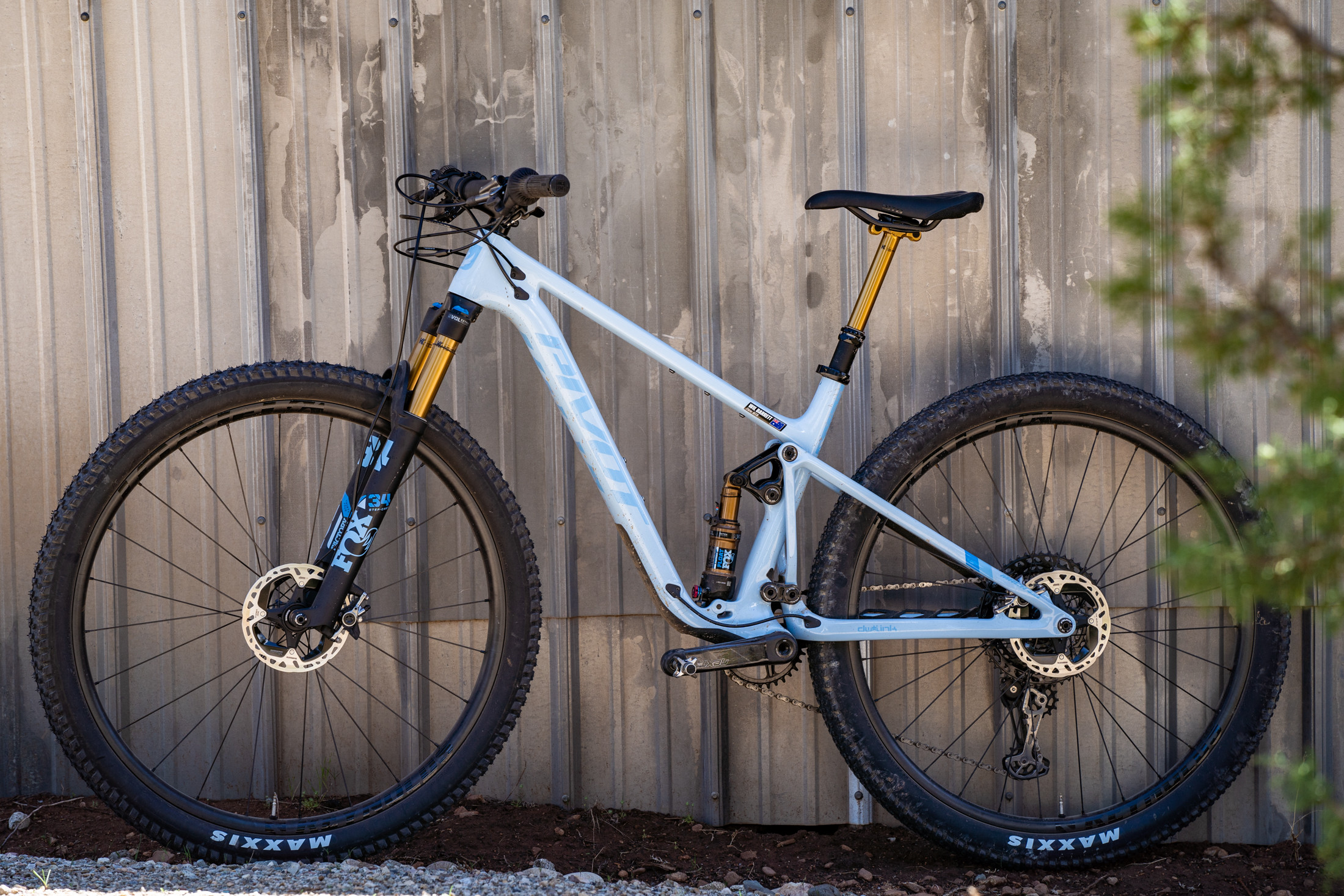 Action shot of the 2023 Pivot Mach 4 SL Team XTR on a trailThe Pivot Mach 4 SL impressed in initial tests and may be included in future group tests after more extensive evaluation.
Action shot of the 2023 Pivot Mach 4 SL Team XTR on a trailThe Pivot Mach 4 SL impressed in initial tests and may be included in future group tests after more extensive evaluation.
What Else is Out There?
Our XC bike review is not exhaustive, and many other excellent full suspension race bikes are available.
Notable bikes not yet reviewed include the BMC Fourstroke, Mondraker F-Podium, and Ibis Exie, which are less common in Australia. We recently tested the new Pivot Mach 4 SL and were impressed. We plan to conduct a long-term test to include it in future comparisons, potentially as a contender for the best XC mountain bike.
We will continue to add new models as we test them and welcome suggestions for future reviews. Brands interested in having their bikes tested are encouraged to contact us.
The updated 2024 Mondraker F-Podium is a bike we are eager to test and compare to the best XC bikes.
What’s the Lightest XC Bike?
Weight is a crucial factor in XC racing discussions. For those focused on minimizing grams, the question is: what is the lightest XC bike available?
Our bike reviews include verified weights, measured tubeless without pedals. However, as we test bikes across different price points, direct weight comparisons can be misleading. Also, some XC bikes are still sold without dropper posts, affecting weight comparisons.
The Canyon Lux World Cup CFR Team is the lightest XC bike in our list at 10.22kg. The Specialized Epic EVO Pro is the heaviest at 12.1kg, but features more travel, a dropper post, and aggressive tires. Weight is a significant factor in the discussion of the best XC mountain bike, but must be considered alongside features and intended use.
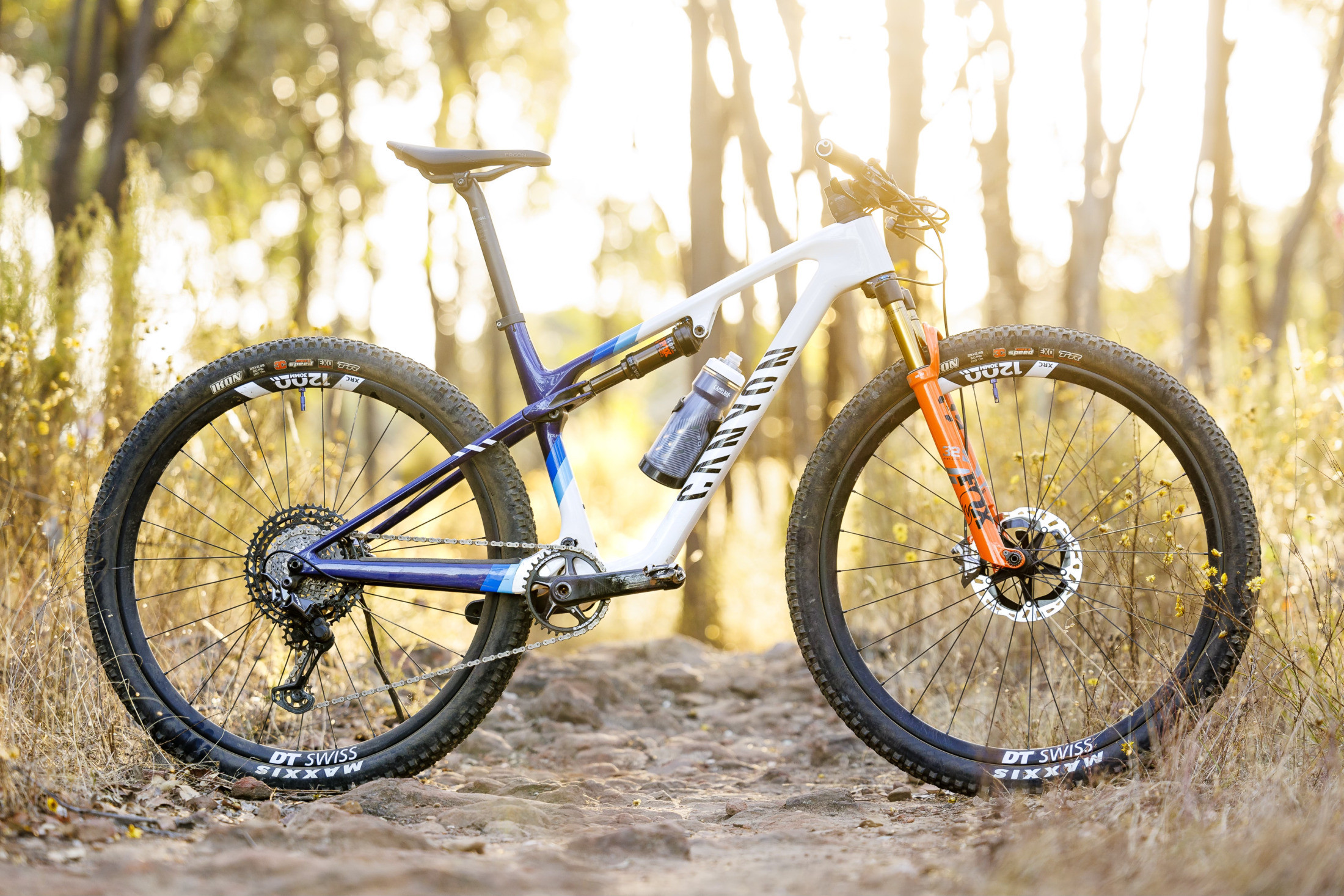 Action shot of the 2023 Canyon Lux World Cup emphasizing its lightweight buildThe Canyon Lux World Cup CFR Team, weighing just 10.22kg, is the lightest bike in our tested selection.
Action shot of the 2023 Canyon Lux World Cup emphasizing its lightweight buildThe Canyon Lux World Cup CFR Team, weighing just 10.22kg, is the lightest bike in our tested selection.
Frame Weights
Frame weight provides a more direct comparison. Below are manufacturer-claimed frame weights, including rear shock and basic hardware:
- Specialized S-Works Epic World Cup – 1,712g
- Cervelo ZFS-5 – 1,718g
- Giant Anthem Advanced Pro – 1,735g
- Specialized S-Works Epic 8 – 1,795g
- Orbea Oiz OMX – 1,798g
- Scott Spark HMX SL – 1,870g
- Canyon Lux World Cup CFR – 1,894g
- Cannondale Scalpel Hi-Mod – 1,910g
- Santa Cruz Blur 4 – 1,933g
- Trek Supercaliber SLR – 1,950g
- Specialized Epic EVO – 1,965g
- Merida Ninety-Six RC – 2,064g
- Pivot Mach 4 SL – 2,087g
- Canyon Lux Trail CFR – 2,104g
- Specialized Epic 8 EVO – 2,210g
- Trek Top Fuel – 2,600g
The Specialized S-Works Epic World Cup frame and shock are claimed to weigh a mere 1,712g for the FACT 12m construction.
The Specialized Epic World Cup frame is claimed to be the lightest at 1,712g.
However, manufacturer claimed weights should be viewed with caution. Details like paint, frame size, and included hardware (or omissions like thru-axles) can vary.
Our verified frame weights, measured with shock and hardware but without thru-axles, are:
- Giant Anthem – 1,807g (w/Fox Float DPS)
- Canyon Lux World Cup CFR – 1,941g (w/Fox Float DPS)
- Specialized S-Works Epic 8 – 1,950g (w/RockShox SIDLuxe)
- Trek Top Fuel – 2,600g (w/RockShox Deluxe)
The Anthem and Lux World Cup are close to claimed weights, and the Top Fuel is accurate. However, the Epic 8 is 155g heavier than claimed, partly due to paint and a downtube protector, as detailed in our S-Works Epic 8 review. Frame weight is a key consideration when seeking the best XC mountain bike for racing.
Modern XC bikes are adopting features like dropper posts and wider bars, along with longer travel forks like the Fox 34 SC and RockShox SID.
So Which Is the Best XC Bike of the Lot?
From our tested group of fourteen, which is the best XC mountain bike? Which should you choose?
All of these bikes are impressive, and the “best” choice depends on your priorities.
Most Efficient
For maximum efficiency, the Trek Supercaliber and Specialized Epic World Cup excel. These short-travel bikes are ideal for sprinters, eliminating the need for remote lockouts. The Epic World Cup’s clean cockpit and tunable shock are preferred, while the Supercaliber offers simpler setup and a dual-lockout option. Both bridge the gap between hardtails and full suspension bikes, though at a premium price. For racers prioritizing speed and efficiency, these are contenders for the best XC mountain bike.
Most Versatile
For comfort and capability, the Trek Top Fuel, Canyon Lux Trail, Orbea Oiz, Scott Spark, and Specialized Epic EVO are the most versatile. Their longer forks and travel provide better grip on technical climbs and smoother descents.
The Epic EVO and Top Fuel are the burliest, lacking remote lockouts, which might deter racers. Lighter tires can improve racing speed, and the Epic EVO’s dual bottle capacity suits multi-day events. However, the Top Fuel is most versatile, configurable as a 140/130mm trail bike, appealing to riders who like to customize setups.
The Lux Trail, Oiz, and Spark are more race-ready with 3-position remote suspension. However, their integrated cockpits can complicate maintenance. The Spark offers the most versatility with adjustable head angle, plush suspension, and longer fork compatibility, making it a strong contender for the best XC mountain bike for all-around riding.
Best Value
For value, the Canyon Lux World Cup and Merida Ninety-Six are outstanding. They offer excellent components for the price, whether buying online from Canyon or locally from a Merida dealer. The Lux World Cup is similar to the Supercaliber and Epic World Cup in handling and efficiency. The Ninety-Six is plusher and closer to the Oiz and Spark in ride quality, making them strong contenders for the best XC mountain bike based on value.
Best Overall
The Giant Anthem, Cervelo ZFS-5, and Specialized Epic 8 balance all attributes without excessive integration or proprietary components. These are excellent modern XC bikes with great geometry, traction, and lightweight frames, representing the best XC mountain bike in terms of overall performance.
The Cervelo ZFS-5 is a top-tier XC bike for riders who prioritize performance over remote lockouts.
The Giant Anthem offers great value across its range, though the single bottle cage and press-fit BB may be drawbacks. The Cervelo ZFS-5 is more practical with a well-designed frame and excellent ride quality, especially the 120/115mm version, making it a strong contender for the best XC mountain bike for performance and practicality.
The Best XC Bike
The Specialized Epic 8 slightly edges out as the top pick. It excels in descending with supportive suspension, a slacker head angle, and longer wheelbase, while remaining efficient on climbs due to custom RockShox dampers. SWAT storage adds all-day appeal. It is arguably the best XC mountain bike available today.
While the S-Works model is expensive, the Comp or Expert models offer many features at a lower price, making the Epic 8 range a compelling choice for the best XC mountain bike.
The Specialized S-Works Epic 8 is the ultimate XC bike in terms of trail performance, provided budget is not a constraint.
Flow’s Verdict
These are the top 14 best XC bikes tested at usabikers.net!
This list is ongoing, and we will continue to add and compare new bikes as we test them.
Modern XC bikes are exceptionally capable. Each bike reviewed impressed us, offering unique characteristics appealing to diverse riders.
If a new bike isn’t feasible, consider our article on top 8 upgrades for your XC bike to enhance your current bike’s performance and address that new bike desire.
Bikes Tested
Editorial Guidelines At usabikers.net, we are dedicated to providing engaging and reliable content, including product reviews, destination features, news, interviews, and in-depth articles. While advertising relationships exist, our editorial team operates independently, prioritizing expertise and passion over commercial influence. Sponsored content is always clearly identified, and we maintain a commitment to honest and unbiased reporting across all publications. For more information, please see our Transparency Report.
